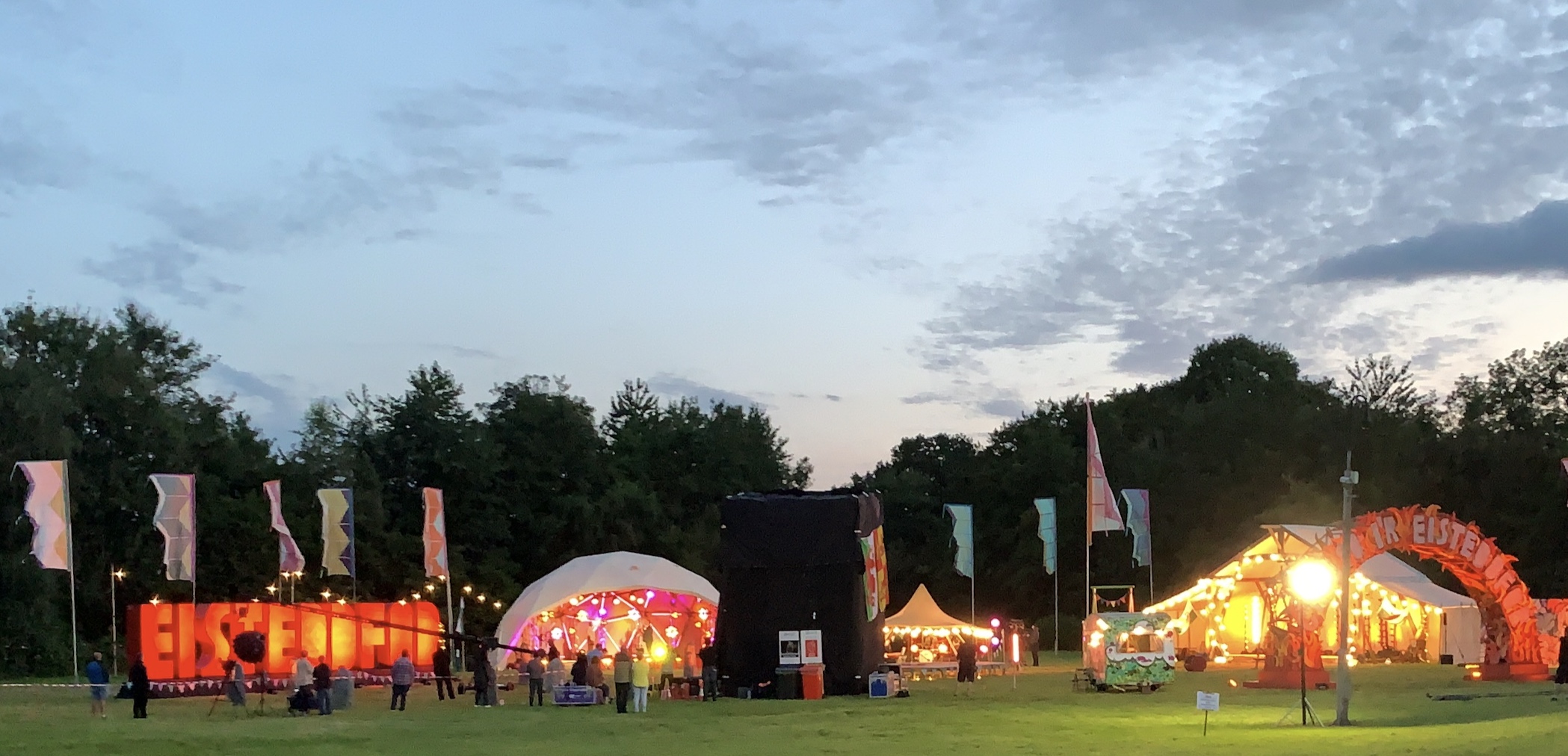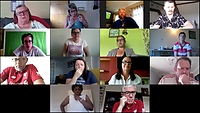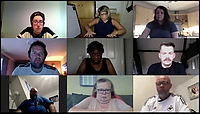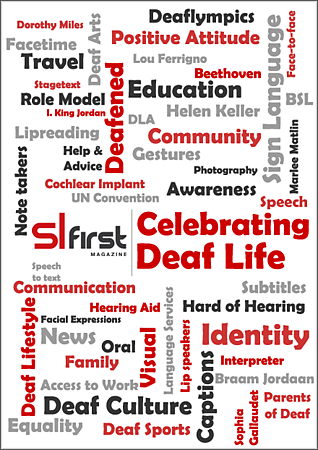Stage, Theatre & TV18th August 2020
Deaf History in the Making - Welsh National Anthem performed in BSL
For the first time in history the Welsh National Anthem was performed in BSL alongside singing choirs at a national event
 “It gave me goose-bumps,” was the most repeated comment from Deaf and hearing alike, when they witnessed the first every BSL signed performance of the Welsh National Anthem at the National Eisteddfod Encore Performance on Saturday 8th August 2020.
“It gave me goose-bumps,” was the most repeated comment from Deaf and hearing alike, when they witnessed the first every BSL signed performance of the Welsh National Anthem at the National Eisteddfod Encore Performance on Saturday 8th August 2020.
The televised showing of the national anthem being properly translated and signed in BSL heralds a new era for British Sign Language in Wales, not just through the magnificent and generous support of the National Eisteddfod team, but also through the planned changes to the national school curriculum across Wales. These are exciting times.
Of course, the TV performance did not happen overnight, it was the culmination of hard work, tenacity and a dedication to accurate translation of meaning from the Deaf team who were pulled together from across Wales and their small support team. Key to the performance was an agreed understanding of the meaning of the lyrics as they were intended to be understood when originally written. The importance of that meaning was summarised by one of the people involved, “Without accurate translation of meaning, the signed performance would look and feel very different, and it would not have been a ‘BSL’ performance. Doing this properly in BSL and in the Welsh regional dialect of BSL at that, was hugely important, and I am so proud of what we have achieved.”
The tiniest acorn of the idea for this performance stemmed from Ruth Fabby MBE, the Director of Disability Arts Cymru and her discussion with the Eisteddfod team. When they were put in touch with Sarah Lawrence, a local Deaf BSL teacher, they were pushing against an open door to get the national anthem signed. Then the hard work kicked in.
First came the translation, and that required an agreement on the true meaning of the first verse and the chorus of the national anthem from Welsh to English. Word for word literal translations can be ignorant of true meaning, especially with the lyrics of songs, so this project was underpinned by a desire for accuracy. It was going to be historic, so it had to be right. Once that translation was agreed, the secondary translation from English to Welsh Regional BSL was undertaken, with the added dimensions of artistry and musicality being included for a performance. “It was exciting to have the opportunity through this performance to show that Deaf people in Wales are equally proud and passionate about their Welsh culture and history, but I also felt the pressure to develop a performance that anyone could visually connect with,” commented Sarah Lawrence the co-ordinator of the Deaf group. “As Deaf people in Wales, we are as passionate about our country as the next man or woman, but we have never had the opportunity to show that at national events when the national anthem was being played. This was our moment, and we had to get it right.”

Through their All-Wales focus, the Eisteddfod team quite rightly wanted 15 Deaf people drawn from across Wales to perform the anthem during the closing event alongside singing choirs from North and South Wales. With no Wales-wide BSL signing group existing, a mad dash recruitment exercise followed along with a fair degree of frustration, “I’m up for it,” on a Monday, followed by, “It’s not for me,” the following Thursday. Reliability and a commitment to join in regular video-conference practice sessions was a minimum requirement, and that proved a little harder than expected. If only the football season hadn’t re-started!
 Many Zoom sessions followed, and with a dedication to get this right, a Welsh BSL signing group formed, each member openly supporting and encouraging each other. Slight adaptations were made to the performance as musicality and timing were introduced, each sign of the performance having to link with the 73 beats per minute speed of the anthem music.
Many Zoom sessions followed, and with a dedication to get this right, a Welsh BSL signing group formed, each member openly supporting and encouraging each other. Slight adaptations were made to the performance as musicality and timing were introduced, each sign of the performance having to link with the 73 beats per minute speed of the anthem music.  For all members of the group, this was the first time that they had truly understood the meaning of their own national anthem. For the first time, the Deaf members could understand why the Welsh National Anthem was voted the best of all the nations competing at the last rugby World Cup, passion, pride and courage oozing from the manual signs, facial expressions and role shift’s that are such a huge aspect of BSL
For all members of the group, this was the first time that they had truly understood the meaning of their own national anthem. For the first time, the Deaf members could understand why the Welsh National Anthem was voted the best of all the nations competing at the last rugby World Cup, passion, pride and courage oozing from the manual signs, facial expressions and role shift’s that are such a huge aspect of BSL
Never short of creative inspiration, the Eisteddfod team’s ambitious aspect of this project was for Sarah Lawrence, assisted by Cathryn McShane, the BSL to Welsh interpreter, to record three workshops for anyone to watch and learn how to sign the national anthem, spreading the awareness of BSL as a full and vibrant language within Wales. People were then invited to submit videos of their performance for consideration of inclusion in the final S4C programme. Ultimately, and maybe surprisingly, the Eisteddfod received far more video recordings than they could include in the final televised show, but we take our hat off to everyone who participated.
 In these strange times of course, it was not possible to have the Eisteddfod performances live on stage. The whole week became an online event, resulting in the national anthem performances being pre-recorded. For the North Wales Deaf team, that meant an early Sunday morning start on Beaumaris Green under the filming direction of the brilliant team from the Orchard Media & Events Group. For the South Wales team, it was an evening recording inside the grounds of Cardiff Castle, and for Eiryth Eynon it was Aberystwyth Castle. All beautiful, iconic backdrops providing the right atmosphere and ambience for such an historic Deaf/BSL moment.
In these strange times of course, it was not possible to have the Eisteddfod performances live on stage. The whole week became an online event, resulting in the national anthem performances being pre-recorded. For the North Wales Deaf team, that meant an early Sunday morning start on Beaumaris Green under the filming direction of the brilliant team from the Orchard Media & Events Group. For the South Wales team, it was an evening recording inside the grounds of Cardiff Castle, and for Eiryth Eynon it was Aberystwyth Castle. All beautiful, iconic backdrops providing the right atmosphere and ambience for such an historic Deaf/BSL moment.
 Dauntingly, Sarah Lawrence was also invited to perform the national anthem on stage alongside Welsh opera great, Sir Bryn Terfel, at the Eisteddfod site at …. Manor, Nelson. A world first for a singing/signed duet of a national anthem at a national event, Sarah was determined to do it. For her, this was a demonstration of language equality, singing and signing alongside each other in a joint performance. Commenting immediately after filming, Sarah told us proudly, “That was just amazing, I loved it. I hope you didn’t see my legs shaking. Bryn Terfel was utterly fabulous, not just with his warmth towards me, but he actually joined in with some of the signing as well. How brilliant is that?”
Dauntingly, Sarah Lawrence was also invited to perform the national anthem on stage alongside Welsh opera great, Sir Bryn Terfel, at the Eisteddfod site at …. Manor, Nelson. A world first for a singing/signed duet of a national anthem at a national event, Sarah was determined to do it. For her, this was a demonstration of language equality, singing and signing alongside each other in a joint performance. Commenting immediately after filming, Sarah told us proudly, “That was just amazing, I loved it. I hope you didn’t see my legs shaking. Bryn Terfel was utterly fabulous, not just with his warmth towards me, but he actually joined in with some of the signing as well. How brilliant is that?”
 With filming done, it was just a matter of waiting for the programme to air on S4C on Saturday the 8th August. Whether watching alone, with Deaf friends or family, all of the members of the Welsh BSL Signing Group anxiously waited for the final performance to draw this year’s Eisteddfod to a close. Nerves jangling, fears rising about what had been edited in and edited out, the anthem was introduced, the performance began, and buckets of pride started pouring out with history being made. The feedback since has been overwhelmingly positive and gracious, with most people recognising the importance of this momentous achievement. The viewing numbers of the recording since have continued to rise, and with worldwide recognition, will continue to do so.
With filming done, it was just a matter of waiting for the programme to air on S4C on Saturday the 8th August. Whether watching alone, with Deaf friends or family, all of the members of the Welsh BSL Signing Group anxiously waited for the final performance to draw this year’s Eisteddfod to a close. Nerves jangling, fears rising about what had been edited in and edited out, the anthem was introduced, the performance began, and buckets of pride started pouring out with history being made. The feedback since has been overwhelmingly positive and gracious, with most people recognising the importance of this momentous achievement. The viewing numbers of the recording since have continued to rise, and with worldwide recognition, will continue to do so.
The history of Wales, so beautifully captured in the Welsh words of the national anthem for all of Wales to sing so passionately whenever and wherever they can, is suddenly accessible to the Deaf community too! The only question that remains, is where and when will the next signed performance of the Welsh national anthem be performed alongside its usual tumultuous and heart-warming rendition.
Summing up on the conclusion of this Eisteddfod programme of inclusion for BSL, Sarah Lawrence said, “I cannot thank enough, the people who made this happen for the Deaf community in Wales and for those of us who are deeply passionate about British Sign Language. A huge supporter of the signing of the American Anthem at the Superbowl, I have held a life-long ambition to sign the Welsh National Anthem at a national event. To be able to do that as part of a Deaf group making what we think is world history by performing to the music alongside established choirs is amazing. I am so proud of each and every one of the Deaf people involved, some of whom have been deeply moved by this experience. Performing as a duet alongside the world-famous Sir Bryn Terfel was the cherry, on top of the cherry, on top of the cake. We have been able to demonstrate our passion for this great Welsh nation and I look forward with hope and aspiration that we will become a world leading nation on inclusivity, fairness and language equality.”
To book Sarah for a workshop on signing the national anthem in BSL, please email sarah@premierbsl.co.uk

Welsh Deaf BSL Signing Group members:
Sarah Lawrence
David Duller
Eiryth Eynon
Elin Williams
Nadene Scott
Jane Duffield
Gillian McCulloch
Michael Thomas
Chris Coles
Paul Williams
Heather Thomas
Ceri Lewis
Bethan Ronan
Julie Rinaldi
Nia Jones

Explanatory note: British Sign Language (BSL) is a visual language used by many Deaf people in the United Kingdom. BSL is a full and vibrant language that uses handshapes, facial expressions, gestures and body language to convey meaning. BSL is a full language with a full and detailed vocabulary. The sentence structure and syntax of BSL is different to both English and Welsh, but it is possible to fully and accurately translate English, Welsh and other languages into BSL and vice versa.
Accuracy is key to the translation of any language into BSL, and accurate translation requires the detailed understanding of the meaning and then the delivery of that meaning into syntactically and linguistically accurate BSL. Translating and then signing by maintaining the English sentence structure is not BSL, it is Sign Supported English (SSE).
BSL was formally recognised by the UK Government and the countries that make up the United Kingdom because it was able to prove that it has the rules and grammar used by other languages. Arguably, the maintenance of those rules and proper application of grammar remain crucial to the future survival of BSL as a recognised language of the United Kingdom.
Article by SLFirst Editorial Team
posted in Entertainment / Stage, Theatre & TV
18th August 2020





